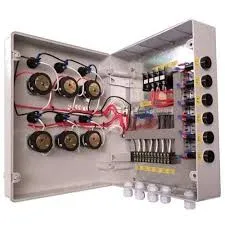The Importance of Automotive Wiring Harness Cloth Tape
In the realm of automotive manufacturing and maintenance, various components play critical roles in ensuring the overall functionality and safety of vehicles. One such component that often goes unnoticed is the wiring harness. The wiring harness is a crucial assembly that binds together multiple wires and connectors, facilitating the transmission of electrical signals throughout the vehicle. However, to protect and enhance the durability of these wiring harnesses, automotive wiring harness cloth tape is employed. This article delves into the significance of cloth tape in the context of automotive wiring harnesses.
What is Automotive Wiring Harness Cloth Tape?
Automotive wiring harness cloth tape is a specialized type of tape made from a fabric-like material, typically reinforced with adhesive on one side. This tape is designed to wrap around wires and connectors, providing insulation, protection from abrasion, and resistance to various environmental factors. The adhesive properties of the tape ensure a secure hold, preventing it from slipping or unraveling during operation.
Protection and Insulation
One of the primary functions of cloth tape is to provide insulation for the wiring harness. Electrical wires can be susceptible to short-circuiting, which can lead to malfunctions and potential safety hazards. By wrapping wires with cloth tape, automotive manufacturers enhance the insulation, ensuring that wires do not come into contact with one another or with any metal surfaces that may cause a short.
Moreover, cloth tape offers protection against external forces. Vehicles often operate in harsh environments where exposure to moisture, dirt, and extreme temperatures is commonplace. The durable nature of automotive wiring harness cloth tape acts as a shield against these elements, preventing corrosion, wear, and tear that could compromise the integrity of the wiring harness.
Noise Reduction
automotive wiring harness cloth tape

Another significant benefit of using cloth tape on wiring harnesses is its ability to reduce noise. As vehicles operate, the vibrations generated by the engine and other components can cause wires to rub against each other or against metal surfaces. This friction can create unwanted noise, which can be distracting for drivers and passengers. The cushioning effect provided by cloth tape helps minimize these vibrations, leading to a quieter operation of the vehicle.
Flexibility and Conformability
One of the reasons automotive wiring harness cloth tape is preferred over other types of insulation materials is its flexibility. The fabric-like texture of the tape allows it to conform seamlessly to the shapes and sizes of various wiring harnesses. Its pliable nature means that it can accommodate complex bends and curves without losing its adhesion or protective properties. This feature is particularly important in the automotive industry, where space is often limited and wiring harnesses need to fit into tight quarters.
Easy Application and Cost-Effectiveness
Automotive wiring harness cloth tape is user-friendly, making it easy to apply during manufacturing or maintenance processes. Technicians can easily unroll the tape, cut it to the desired length, and wrap it around the wiring harness with minimal effort. This ease of application, combined with its excellent performance characteristics, makes it a cost-effective solution for vehicle manufacturers and repair shops alike.
Conclusion
In conclusion, automotive wiring harness cloth tape is an essential component in the automotive industry, providing insulation, protection, noise reduction, flexibility, and ease of use. As vehicles become more technologically advanced and reliant on electrical systems, the importance of safeguarding the wiring harness cannot be overstated. Investing in high-quality cloth tape for automotive wiring harnesses not only enhances vehicle performance but also contributes to overall safety and longevity. Whether in manufacturing settings or in automotive repair, the proper use of wiring harness cloth tape will continue to play a crucial role in the evolution of automotive technology.
-
The Versatility of Cloth Insulation TapeNewsApr.07,2025
-
The Power of Self Amalgamating Silicone TapeNewsApr.07,2025
-
The Importance of Weatherstrip Seal: Your Ultimate Protection SolutionNewsApr.07,2025
-
Tape Electrical Insulation: A Reliable Solution for Your Electrical NeedsNewsApr.07,2025
-
Discover the Wonders of Electrical Splicing TapeNewsApr.07,2025
-
Discover the Versatility of PVC Electrical TapeNewsApr.07,2025
